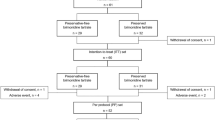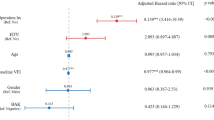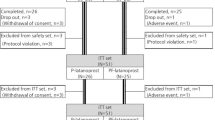Abstract
Introduction Brimonidine 0.2% (Alphagan®) is a topical alpha-2 agonist widely used as an antihypertensive. There have been occasional reports of systemic adverse effects in children including apparent central nervous system depression. There are few data available on the overall safety of brimonidine 0.2% in children.
Methods Computerised pharmacy records were used to identify all children who had been prescribed brimonidine 0.2% in our eye department between August 1999 and June 2001, and their notes were reviewed.
Results In all, 23 patients were identified from pharmacy records and 22 sets of notes were recovered and reviewed. The mean age at commencement of treatment was 8 years (range 0–14 years). In all, 10 (46%) were treated in one eye and 12 (54%) in both. Brimonidine 0.2% was taken for a mean 14 months (range 1 day–75 months). A total of 14 (64%) patients were already taking a topical beta-blocker when brimonidine 0.2% was commenced and a further four (18%) were being treated with another topical hypotensive agent. Of the 22 patients, six (27%) had to stop brimonidine 0.2% because of adverse side effects (two because of local irritation/allergy, two because of tiredness, and two because of fainting attacks).
Discussion Many topical hypotensive agents are not licensed for use in children and few safety data are available. In this study, 18% of children had systemic adverse effects sufficient to necessitate stopping the drug. It is possible that educational impairment may have passed unnoticed in others. Larger studies are required to investigate this further.
Similar content being viewed by others
Introduction
Brimonidine 0.2% is a topical alpha-2 agonist that is widely used as an antihypertensive. There have been occasional reports of systemic adverse effects in infants including apparent central nervous system depression,1,2,3,4 but there are few data available on the overall safety of brimonidine 0.2% in children.
Methods
Computerised pharmacy records were used to identify all children who had been prescribed brimonidine 0.2% in our eye department between August 1999 and June 2001, and their notes were reviewed. Patient sex, age, glaucoma type and medical history were recorded together with dates of commencing and ceasing brimonidine 0.2% therapy, details of other medical and surgical glaucoma therapies, side effects attributed to brimonidine 0.2%, and reasons for ceasing brimonidine 0.2%.
Results
In all, 23 patients were identified from pharmacy records and 22 sets of notes were recovered and reviewed. Of the 22 patients treated, nine (41%) were male and 13 (59%) female. The mean age at commencement of treatment was 8 years (range 2–14). A total of 10 (46%) were treated in one eye and 12 (54%) in both. Brimonidine 0.2% was taken for a mean 14 months (range 1 day–75 months). Glaucoma type was primary congenital in two, aphakic in seven, inflammatory in six, port wine stain related in three, and other types of glaucoma in four.
Brimonidine 0.2% was always an adjunctive topical medication with 14 (64%) patients already taking a topical beta-blocker, nine (41%) taking dorzolamide 2% (Trusopt®), four (18%) taking latanoprost 0.005% (Xalatan®), three (14%) taking pilocarpine 2%, and one taking systemic acetazolamide. A total of 11 patients (50%) were on two or more additional glaucoma medications. In all, 15 (68%) patients had undergone previous ophthalmic surgery or laser before brimonidine 0.2% was commenced. Of the 22 patients, six (27%) had to stop the drop because of adverse side effects (two because of local irritation/allergy, two because of tiredness, and two because of fainting attacks). In the two who fainted (both aged 10 years), brimonidine 0.2% was stopped in one after 10 days having had one faint and in the other after 40 days having had eight fainting attacks and one generalised skin rash. In the two who experienced drowsiness (aged 6 and 12 years), the drop was stopped after 6 and 7 months. In the two (aged 5 and 8 years) who had a local reaction, brimonidine 0.2% was stopped after 1 day (patient experienced extreme ocular discomfort on administration of brimonidine and stopped taking it without presenting for examination) and 21 months (patient was atopic and developed a follicular conjunctivitis that resolved on cessation of brimonidine 0.2%). Of the four patients experiencing systemic adverse effects, two had asthma but the others had no medical history. All four patients who had to stop brimonidine 0.2% because of local side effects or drowsiness were on additional topical beta-blockers and two (one with local side effects and one with drowsiness) were also on dorzolamide 2%, but in all six cases the symptoms improved with cessation of brimonidine 0.2%.
Discussion
Brimonidine is a selective alpha-2 adrenoceptor agonist that readily crosses the blood–brain barrier. In preclinical monkey studies there was some evidence that the drug achieved its ocular hypotensive affect by acting on CNS receptors,5 but in humans it is thought to act peripherally suppressing aqueous production, and increasing uveoscleral outflow. Side effects of brimonidine include sedation, mediated by postsynaptic receptors located in the locus coeruleus, behind the blood–brain barrier; hypotension and bradycardia, which are thought to be related to both central and peripheral actions. The production of hypotension as well as sedation by alpha-2 agonists has been shown to correlate well with their ability to cross the blood–brain barrier. Anterior segment vasoconstriction has been noted with topical brimonidine 0.2% presumably mediated via local extrajunctional alpha-2 receptors.6
Topical brimonidine 0.2% is widely used in adults for long-term glaucoma treatment and is known to be associated with topical and systemic adverse effects. The frequency of ocular side effects (conjunctival hyperaemia, blepharitis, allergy, conjunctival oedema, conjunctival follicles, foreign body sensation, burning, blurring) in adult series ranges from 27 to 38%.7,8 The frequency of systemic adverse effects (drowsiness, shortness of breath, dizziness, headache, low mood) in adult series varies from 20 to 52%,9,10 with one study showing them to be more common in patients older than 60 years10 and another showing increased drug concentration to be a risk factor (three concentrations tested: 0.08, 0.2 and 0.5%).7 Terminations of therapy because of adverse effects in adults were as low as 4%9 in one study and as high as 26% in another10 (approximately twice as many systemic as local side effects, a similar finding to our study in children). A minor reduction in adult systolic blood pressure (2.8 mmHg, SD=20, n=34) associated with brimonidine 0.2% has been reported with no effect on diastolic blood pressure or pulse rate.8 Acute psychosis has been reported in one 68-year-old man.11
Many topical hypotensive agents are not licensed for use in children and few safety data are available. In 1998, the manufacturer of topical brimonidine 0.2% (Alphagan®; Allergan, Irvine, CA, USA) recommended that Alphagan® not be used in children after reports that two infants had suffered bradycardia, hypotension, hypothermia, hypotonia, and apnoea (Joseph Lambert MD, Allergan: notification of labelling change to Pediatric Use section of Alphagan®, 12 January 1998). To our knowledge there have been five previously published case reports of such adverse effects affecting infants1,2,3,4 and one published series to indicate the incidence of adverse effects in children.12
Of the five previous case reports in infants, the first case involved a 3-month-old (also on latanoprost 0.005%) who became stuporous with rapid breathing and dry mucous membranes 20 min after application of one drop of brimonidine 0.2%. Gradual recovery was observed over 20 h without treatment.1 A second paper reported two cases:2 an 11-day-old infant who became lethargic, apnoeic, floppy and pale 10 min after the first drop of brimonidine 0.2%, and a 5-month-old who suffered similar symptoms lasting 2.5 h. A fourth case involved an 8-week-old who presented with severe floppy episodes leading to unconsciousness 10 days after commencing topical brimonidine 0.2%. The symptoms resolved after withdrawal of the drug.3 A fifth case involved a 4-week-old who suffered intermittent coma without apnoea (responsive to naloxone therapy), which was related to brimonidine 0.2% administration. Plasma brimonidine concentrations were 1459 and 700 pg/ml drawn 0–3 and 6 h after administration, respectively. Plasma concentrations from adult studies show a maximum concentration of 60 pg/ml.4
The only previously published series of children treated with Alphagan® (n=30, mean age 10.5 years, mean follow-up 10.8 months) reported that two young children (aged 2.4 and 3.7 years) became unrousable repeatedly after administration of brimonidine and that five other children (aged 4.0–14.4 years) experienced extreme fatigue after administration of the drug.12 No local side effects were reported.
Significant systemic absorption of brimonidine eye drops occurs in adults, peak plasma concentrations occurring within 1–4 h with a half-life of approximately 2.5 h. Systemic metabolism of brimonidine is primarily by the liver and urinary excretion is the major route of elimination of the drug and its metabolites. The increased sensitivity of infants to brimonidine could be because of their size (no dose adjustment is made), excessive systemic absorption, immature metabolism and excretion (hepatic phase I reactions do not reach maturity until 6 months of age), an immature blood–brain barrier, or increased receptor sensitivity. Although high plasma concentrations may account for systemic adverse effects seen in infants, they are unlikely to account for fainting and fatigue in older children.
In this study, 18% of children had systemic adverse effects sufficient to necessitate stopping the drug. The mean age of this subgroup was 9.5 years (6–12 years). It is possible that educational impairment may have passed unnoticed in others. Although larger studies are preferable, randomised controlled trials with drugs unlicensed in children are ethically difficult. We suggest that topical brimonidine should not be used in infants and only with caution even in older children. Possible strategies for reducing risk of systemic adverse effects in children for whom it is considered essential might include dose reduction or dilution by the pharmacist, blotting of excess drops from the lids, and application of digital pressure to the puncti and/or canaliculi for 3 min after installation.
References
Korsch E, Grote A, Seybold M, Soditt V . Systemic adverse effects of topical treatment with brimonidine in an infant with secondary glaucoma. Eur J Pediatr 1999; 158(8): 685.
Carlsen JO, Zabriskie NA, Kwon YH, Barbe ME, Scott WE . Apparent central nervous system depression in infants after the use of topical brimonidine. Am J Ophthalmol 1999; 128(2): 255–256.
Walters G, Taylor RH . Severe systemic toxicity caused by brimonidine drops in an infant with presumed juvenile xanthogranuloma. Eye 1999; 13 (Part 6): 797–798.
Berlin RJ, Lee UT, Samples JR et al. Ophthalmic drops causing coma in an infant. J Pediatr 2001; 138(3): 441–443.
Burke J, Schwartz M . Preclinical evaluation of brimonidine. Surv Ophthalmol 1996; 41 (Suppl 1): S9–S18.
Robin AL, Burnstein Y . Selectivity of site of action and systemic effects of topical alpha agonists. Curr Opin Ophthalmol 1998; 9(2): 30–33.
Derick RJ, Robin AL, Walters TR et al. Brimonidine tartrate. A one month dose response study. Ophthalmol 1997; 104: 131–136.
Waldock A, Snape J, Graham CM . Effects of glaucoma medications on the cardiorespiratory and intraocular pressure status of newly diagnosed glaucoma patients. Br J Ophthalmol 2000; 84(7): 710–713.
Serle J and the brimonidine study group III. A comparison of the safety and efficacy of twice daily rimonidine 0.2% versus betaxolol 0.25% in subjects with elevated intraocular pressure. Surv Ophthalmol 1996; 41 (Suppl 1): S39–S47.
Detry-Morel M, Dutrieux C . Treatment of glaucoma with brimonidine (Alphagan 0.2%). J Fr Ophtalmol 2000; 23(8): 763–768 (French).
Kim DD . A case of suspected alphagan-induced psychosis. Arch Ophthalmol 2000; 118(8): 1132–1133.
Enyedi LB, Freedman SF . Safety and efficacy of brimonidine in children with glaucoma. J Am Assoc Pediatr Ophthalmol Strab 2001; 5(5): 281–284.
Author information
Authors and Affiliations
Corresponding author
Rights and permissions
About this article
Cite this article
Bowman, R., Cope, J. & Nischal, K. Ocular and systemic side effects of brimonidine 0.2% eye drops (Alphagan®) in children. Eye 18, 24–26 (2004). https://doi.org/10.1038/sj.eye.6700520
Received:
Accepted:
Published:
Issue Date:
DOI: https://doi.org/10.1038/sj.eye.6700520
Keywords
This article is cited by
-
Elucidating doxycycline loading and release performance of imprinted hydrogels with different cross-linker concentrations: a computational and experimental study
Journal of Polymer Research (2021)
-
Pediatric Glaucoma: Pharmacotherapeutic Options
Pediatric Drugs (2016)



